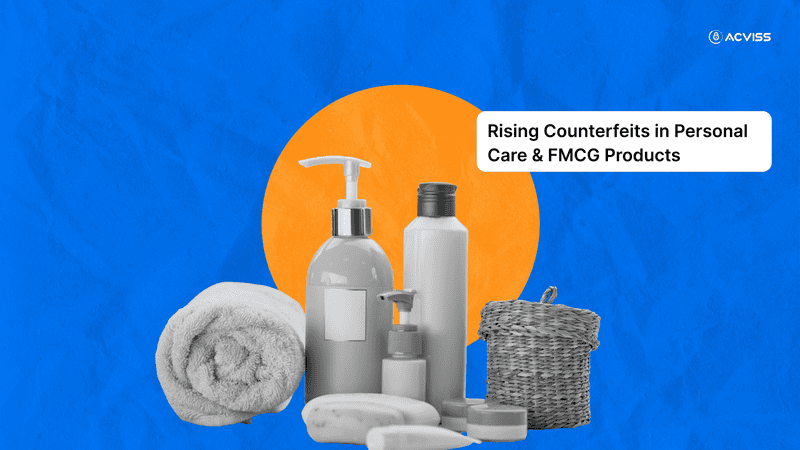How to Prevent the Rising Counterfeits in Personal Care & FMCG Products

Imagine picking up a familiar shade of shampoo or a trusted moisturiser, and scanning the label’s promise of quality, safety and brand integrity. You expect the product in your hand to be the genuine article, but what if that expectation is faulty? What if the bottle you’re about to use has been produced by cloaked counterfeit operations, masquerading behind familiar branding, but offering none of the authenticity, safety or brand value you assume?
For brands in the personal-care and fast-moving consumer goods (FMCG) sectors, this scenario is more than hypothetical. The scale and sophistication of counterfeiting are rising, and the consequences extend far beyond lost sales. They touch on consumer safety, intellectual property (IP) protection, brand trust, supply-chain integrity and regulatory risk. I’ve worked for decades analysing industry trends, and the warning lights are flashing red today. Let’s take a detailed, seasoned look at why counterfeiting is booming in personal care & FMCG, the implications for brands, and what practical solutions exist, including traceability, track and trace technologies, and authentication systems.
The Rising Tide of Counterfeiting in FMCG & Personal Care
Counterfeiting isn’t confined to luxury goods or high-end designer products. It has steadily spread into the everyday categories of personal care, household goods and FMCG. In India, for example, one report found that “almost 25-30 % of all products sold in the country are spurious”, with the FMCG sector accounting for about 28 % of consumer-reported counterfeits.
The report covered 12 cities and included goods ranging from cooking oil and baby-care items to personal care and medicines. Another earlier study noted that counterfeit incidents in India surged 24 % in 2019 over the prior year, causing over Rs 1 lakh crore of economic damage.
These figures tell a clear story: counterfeiting is no longer a niche luxury-goods issue. It is a systemic threat in categories that touch the consumer daily.
Why Personal Care & FMCG Are Vulnerable
1. High Demand and Frequent Purchase Cycles
Items such as soap, shampoo, deodorant, toothpaste, packaged foods and beverages are purchased repeatedly, often on impulse. That high turnover creates many entry points for counterfeiters to slip in.
2. Packaging Similarity and Low Cost Barriers
Counterfeiters recognise that small-value goods still generate large volumes. Packaging can be mimicked, labels faked, and bulk margins extracted. In many instances, the cost of producing a fake version is very low compared with the brand’s market value.
3. Complex, Multi-Tier Supply Chains
FMCG brands typically rely on multi-tiered distribution, with raw material sourcing, contract manufacturing, secondary packaging, logistics hubs and local warehouse networks. Each link is a potential point of vulnerability for counterfeiters to insert fake goods. Effective supply chain management becomes challenging.
4. E-commerce and Omni-channel Exposure
Online marketplaces and consumer-to-consumer platforms have amplified risk. The distribution of counterfeit personal-care goods no longer requires physical storefronts; fake listings can proliferate globally with minimal overhead. As noted, digital platforms complicate the enforcement of intellectual property (IP) protection and digital IP abuse.
5. Consumer Trust & Safety Risks
Unlike luxury goods, where perhaps the risk is mostly economic, personal-care and FMCG products often touch human bodies and health. Fake shampoos, lotions, packaged foods or beverages may bypass safety standards entirely, posing serious physical risk and further undermining brand trust.
How Brands Can Respond: Solutions for Protection & Traceability

In tackling this challenge, there are two complementary strands: product authentication and supply-chain traceability. Both are vital for a modern brand protection strategy.
1. Product Authentication: Verifying Genuine Goods
Authentication enables the consumer or brand to check whether a product is genuine. Techniques include tamper-evident seals, holograms, QR codes, smartphone scans, and blockchain-based identity.
What matters increasingly is using non-cloneable technology, features that cannot be easily replicated by counterfeiters. Recent research highlights micro-pattern anti-counterfeiting labels with exceptional uniqueness and resistance to cloning.
For instance, a brand may incorporate a solution like Certify from Acviss: unique, non-cloneable security codes that allow customers to verify authenticity instantly and the brand to grant visibility into manufacturing data such as name, place and date.
2. Track & Trace: From Factory to Consumer
Authenticating individual units is one step. Ensuring full product traceability from raw material to end-consumer strengthens every link in the chain. Technologies such as serialisation, blockchain ledgers, IoT sensors and RFID tags deliver transparency. For example, research shows that blockchain plus physically unclonable functions (PUFs) for supply-chain tracking significantly enhances control in multi-tier networks.
A robust track and trace system allows a brand to monitor movement, detect suspicious divergence (e.g., unusual routing or stock volumes), and intervene when irregularities appear. It supports supply chain management by reducing leakages and enabling root-cause analysis.
3. Digital IP Protection: Addressing the Online Frontier
Given the explosion of e-commerce, counterfeiting is no longer purely physical. Brands must guard their intellectual property protection and online IP protection by scanning marketplaces, removing listings, using AI to monitor and taking down infringers. For instance, AI tools can detect fake listings or suspicious vendors and trigger takedown processes.
4. Consumer Engagement as a Force Multiplier
Offering product authenticity checks via smartphone empowers the consumer. It builds brand verification and brand authentication into the purchase experience, reinforcing trust and encouraging repeat purchases. Engaging consumers with loyalty programmes (e.g., via customer engagement apps) also ties back into tracking usage, satisfaction and advocacy.
5. Holistic Framework – From Brand to Shelf
An integrated approach means combining authentication, traceability, digital monitoring, and consumer engagement. Brands that do so can shift from reactive to proactive, detecting issues early and protecting product safety, brand equity and market share.
A Practical Roadmap for Personal-Care & FMCG Brands
Here’s a high-level roadmap that brands can follow to move from reactive-response to proactive brand-protection mode.
Step 1: Risk assessment & mapping
- Identify SKUs most at risk (high-volume, high-brand-visibility, high-online penetration).
- Map the full supply chain and distribution channels, both offline and online.
- Assess current leakage points, past counterfeit incidents, grey-market flows and online seller exposures.
- Quantify potential loss: revenue leakage, IP-enforcement cost, brand-trust damage, and regulatory risk.
Step 2: Build your authentication & traceability framework
- Choose a tamper-evident, non-cloneable code or label system (e.g. packaging-embedded unique codes).
- Implement serialisation on identified SKUs, and integrate scan-verification infrastructure (mobile or web).
- Build track-and-trace visibility: each unit’s journey from packing to retail is logged.
- Set up analytics dashboards: monitor scans, verification failure rates, unusual patterns (e.g. many scans from one location).
Step 3: Strengthen digital-IP monitoring
- Deploy digital-monitoring tools for e-commerce listings, social-media adverts, and grey-seller networks.
- Define standard response protocols (take-down notices, seller black-listing, legal escalation).
- Create consumer-report channels (brand website, app) for suspected counterfeits.
Step 4: Consumer engagement & education
- Launch consumer-facing campaigns to raise awareness of product authenticity, risks of counterfeit goods and how to verify.
- Encourage consumers to scan codes and engage with the brand; tie verification to loyalty rewards or value-added content.
- Gather consumer data from scans: where, when, which SKUs, enable feedback loops and regional risk alerts.
Step 5: Continue supply-chain governance
- Work with contract packers and distribution partners to ensure traceability protocols are followed.
- Monitor each regional market for diversion or grey-flow into unauthorised channels.
- Regular audits of supply chain nodes, unexpected shipment patterns or returns anomalies.
Step 6: Measure, refine and scale
- Set KPIs: reduction in counterfeit incidents, increase in consumer scans, time-to-take-down listings, and supply-chain leakages detected.
- Review data regularly and refine: which SKUs remain vulnerable, which markets show elevated risk, which online channels are hotspots.
- Gradually scale the solution to more SKUs, geographies and channels.
The Future: What Brands Must Prepare For

As we look ahead, several emerging dynamics will further shape the anti-counterfeiting landscape in personal care and FMCG.
1. Greater online-first threats
As social commerce, livestream shopping and influencer sales grow, counterfeiters will exploit those channels. Brands must adapt their “online IP protection” strategies accordingly.
2. Increasing regulatory focus
Regulators are becoming more demanding around product safety, authenticity and traceability. For example, chemical-safety reform in cosmetics and personal-care goods is tightening oversight. Fake or unsafe goods may trigger not just brand damage, but legal liability.
3. Smarter supply chains
Blockchain, AI-driven traceability, IoT sensors and real-time analytics will move from “nice-to-have” to “must-have”. Brands that fail to adopt such technologies risk being three to five years behind the leading edge.
4. Consumer expectation of authenticity
Consumers are increasingly aware, expect authenticity verification, and are vocal when trust is breached. Brands will be judged not just on product quality but on how well they protect consumers from counterfeits.
5. Collaboration across industry
No brand fights this alone. Industry associations, enforcement agencies, technology partners and consumer groups will need to collaborate. Shared databases of counterfeit trends, marketplace-take-down coordination and cross-brand intelligence will become more common.
Why This Matters for Your Brand Right Now
If you are a brand owner in personal care or FMCG, you must treat counterfeiting as a strategic risk, not just a retail-loss issue. Consider:
- Your brand equity and consumer trust may be your most valuable assets; once damaged, it is hard to repair.
- A counterfeit incident in personal care may cause a safety issue and trigger regulatory investigations, recalls or liability claims.
- Your supply-chain integrity is under threat from both physical infiltration and digital IP abuse.
- Consumers increasingly demand verification and authenticity; failing to deliver may cost you loyalty and market share.
- Technology solutions now exist at scale and cost-effectively for large-volume sectors; delaying implementation may widen your risk window.
Final Thoughts
If your brand is serious about protecting its reputation, safeguarding its customers, securing its supply chain, and maintaining competitive advantage, then now is the time to act. Establish your roadmap, mobilise cross-functional teams, invest in traceability and authentication, engage your consumers and build a proactive defence against counterfeiting.
If you’re ready to explore how your brand can build a robust anti-counterfeiting and traceability programme, leveraging solutions for product verification, brand authentication, and customer engagement, get in touch with us today. Let’s secure your brand, protect your customers and safeguard your supply chain.
